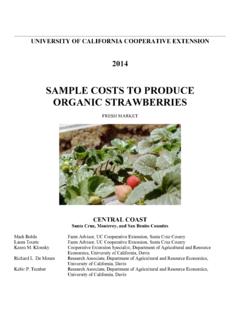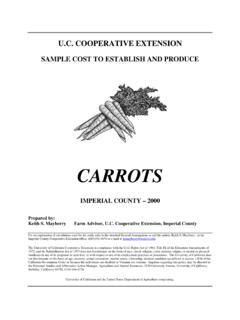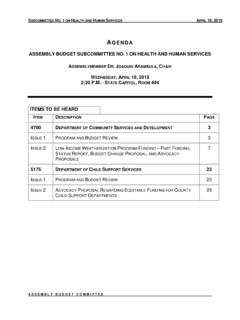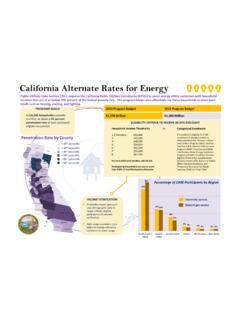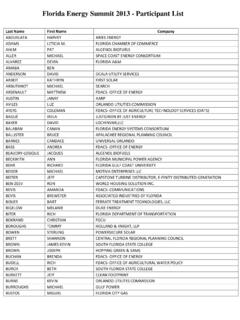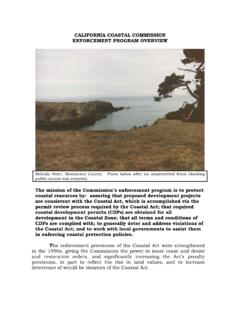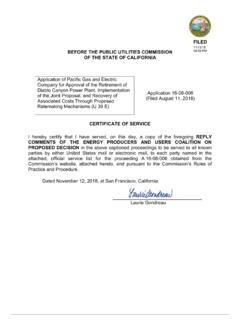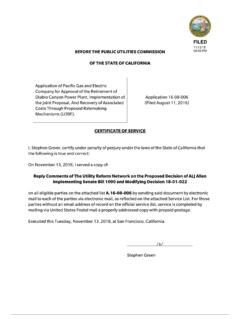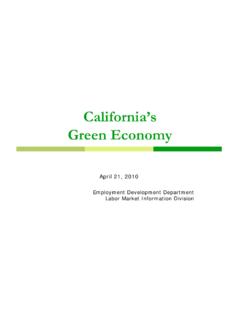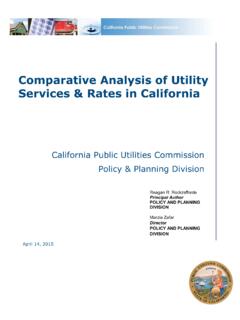Transcription of Sample Costs to Produce and Harvest Iceberg Lettuce ...
1 University of California Agriculture and Natural Resources Cooperative Extension and Agricultural Issues Center UC Davis Department of Agricultural and Resource Economics 2017 Sample Costs TO Produce AND Harvest Iceberg Lettuce central COAST REGION Monterey, Santa Cruz, and San Benito Counties Laura Tourte UC Cooperative Extension Farm Advisor, Santa Cruz, Monterey and San Benito Counties Richard F. Smith UC Cooperative Extension Farm Advisor, Monterey, Santa Cruz and San Benito Counties Jeremy Murdock Staff Research Associate, Agricultural Issues Center, Department of Agricultural and Resource Economics, UC Davis Daniel A. Sumner Director, Agricultural Issues Center, Costs and Returns Program, Professor, Department of Agricultural and Resource Economics, UC Davis 2 Iceberg Lettuce Costs & Returns Study central Coast 2017 UCCE, UC-AIC, UC DAVIS-ARE University of California Agriculture and Natural Resources Cooperative Extension and Agricultural Issues Center UC Davis Department of Agricultural and Resource Economics Sample Costs TO Produce AND Harvest Iceberg Lettuce - 2017 central Coast - Monterey, Santa Cruz, and San Benito Counties CONTENTS 2 3 Production Cultural Practices and Material 3 Growing 5 Labor, Interest, and Cash.
2 7 Non-Cash 8 Table 1. Costs Per Acre to Produce and Harvest Iceberg 11 Table 2. Material and Input Costs Per Acre to Produce and Harvest Iceberg 13 Table 3. Monthly Cash Costs per Acre to Produce and Harvest Iceberg 14 Table 4. Ranging Table 5. Whole Farm Annual Equipment, Investment, and Business Overhead 16 Tabl e 6. Hourly Equipment Acknowledgements. Appreciation is expressed to the central Coast growers, packers, input suppliers, and other industry representatives who provided information, assistance, and expertise for this study. INTRODUCTION The Sample Costs to Produce and Harvest Iceberg Lettuce in the central Coast Region Monterey, Santa Cruz, and San Benito Counties are presented in this study. The study is intended as a guide only, and can be used to make production decisions, determine potential returns, prepare budgets and evaluate production loans. The practices described are based on production procedures considered typical for this crop and area, but will not apply to every situation.
3 Sample Costs for labor, materials, equipment, and custom services are based on current figures. A blank column titled Your Cost is provided to enter your actual Costs on Tables 1 and 2. The hypothetical farm operation, production practices, overhead, and calculations are described under assumptions. For additional information or explanation of calculations used in the study, call the Department of Agricultural and Resource Economics, University of California, Davis, (530) 752-4651, Laura Tourte, UC Cooperative Extension Santa Cruz County (831) 763-8005, Richard Smith, UC Cooperative Extension Monterey County (831) 759-7357, or the local UC Cooperative Extension office. Sample Cost of Production studies for many commodities are available and can be downloaded from the website Archived studies are also available on the website. The University of California is an affirmative action/equal opportunity employer.
4 3 Iceberg Lettuce Costs & Returns Study central Coast 2017 UCCE, UC-AIC, UC DAVIS-ARE ASSUMPTIONS The following assumptions refer to Tables 1 through 6 and pertain to Sample Costs to Produce and Harvest Iceberg Lettuce for the central Coast Region Monterey, Santa Cruz, and San Benito Counties. Sample Costs are given for tractor, fuel, repairs, labor, materials, and custom services and are based on current figures. Costs per acre can vary considerably depending upon many variables including individual grower, production location and weather conditions, land rent and taxes, soil type, water Costs , pest pressures, material inputs, and energy Costs . For example, Lettuce produced in areas with heavy clay soils may have higher land preparation Costs per acre than areas with sandy soils. Areas with sandy soils, in turn, will likely have higher water use and irrigation Costs per acre than areas with heavy clay soils.
5 The practices and Costs used in this study may not be applicable to all situations or used in each production year. Individual growers may use this study as a template and modify it to more accurately reflect their own situations. Additional Iceberg Lettuce production information for California is available online from the University of California Division of Agriculture and Natural Resources at: The use of trade names and cultural practices in this report does not constitute an endorsement or recommendation by the University of California, nor is any criticism implied by omission of other similar products or cultural practices. Farm. This study assumes a farm operation of 1,500 non-contiguous acres of rented land. Roads and buffer zones comprise roughly six percent of the acreage. Iceberg Lettuce is planted on 250 acres and rotated with other Lettuce and cool season vegetable crops to assist with pest management and soil fertility.
6 Lettuce is planted continuously from late December to mid-August along the central Coast. Monterey County has a host-free period (December 7 through 21) for management of Lettuce mosaic virus (LMV), during which time Lettuce may not be planted. Typically, a farm can Produce up to two vegetable crops per year on each field. Costs that affect both crops are allocated accordingly. Land rents for row crops range from a low of $450 to a high of $3,300 per acre per year in the area. For this study, an annual rental rate of $2,700 per acre per year is assumed, with $1,350 allocated to the Lettuce crop. Production Cultural Practices and Material Inputs Land Preparation. Prior to land preparation, and to help determine fertilization practices, a total of 12 soil samples per 250 acres are taken for analysis. In this study, land preparation is assumed to begin in October and November of the year preceding planting and includes discing (four times), subsoiling (twice), land and laser leveling (once each for every 2 crops).
7 Compost is then custom applied at the rate of four tons per acre (or two tons for the Lettuce crop), the acreage chiseled (a total of four times), disced (twice), and beds listed. In January, the beds are cultivated (twice) with a rolling cultivator (Lilliston), and then shaped with a power mulcher. Plant/Stand Establishment. Iceberg Lettuce is direct-seeded using an 80-inch 5-row 3-bed precision air-planter. This study assumes that Lettuce is planted in January at the rate of 157,500 seeds per acre using a in-row spacing and then thinned to a 9-inch in-row spacing approximately 14 to 21 days after planting using an automated thinner; some growers use contract or field labor to perform this operation. The 4 Iceberg Lettuce Costs & Returns Study central Coast 2017 UCCE, UC-AIC, UC DAVIS-ARE use of an automated thinner does not reduce the cost of this practice at present but instead allows growers to perform the operation in a timely manner given labor constraints.
8 Fertilizer/Soil Amendments. In addition to the compost applied during the tillage operations noted above, potassium sulfate is custom applied prior to planting at the rate of 150 pounds per acre. At planting, an anti-crustant (7-7-0-7) is custom applied at the rate of 30 gallons per acre, which supplies 22 pounds of nitrogen (N) to the crop. During the automated thinning process a fertilizer (28-0-0-5) is applied at the rate of 20 gallons or 62 pounds N per acre. A liquid fertilizer (20-0-0-5) is injected into the drip irrigation system once in late February and once in March for a total of 37 gallons per acre or 78 pounds N per acre. A total of 162 pounds of N per acre is applied during the season. The amount of fertilizer used in this study is an average amount; fertilization practices and rates vary and depend soil type, irrigation system, amount of nitrate-N in irrigation water, and quantity of residual soil nitrate-N.
9 Irrigation. For this study, the estimated cost of pumped water is $216 per acre-foot or $18 per acre-inch. Water Costs vary considerably in the area depending upon the water district or agency, delivery, associated fees, and pumping variables. Approximately 4 acre-inches of water are applied through sprinklers three times during stand establishment: 3 acre-inches during the first 6 to 10 days after planting and another 1 acre-inch during the week prior to thinning. An additional 10 acre-inches are applied through the drip system during the remainder of the growing season (February, March, and April) for a seasonal total of 14 acre-inches per acre. Labor Costs include time to set up and monitor the sprinkler and drip irrigation systems for proper function. Total water use will vary depending upon factors such as irrigation method, soil type, weather, and the time of the year the crop is planted.
10 Pest Management. Information for specific pest management materials and the associated application rates can be found in the UC Integrated Pest Management (IPM) Guidelines for Lettuce . For more information on pest identification, monitoring, and pest management materials, visit the UC IPM website at: Written recommendations are required for many commercially applied pesticides and are made by licensed pest control advisers. For information and pesticide use permits, contact your local county Agricultural Commissioner s office. Pest Control Adviser/Certified Crop Adviser (PCA/CCA). A PCA/CCA monitors the field for insects, diseases, irrigation, nutrition, and other production needs to determine the necessary management practices. The cost for a PCA in this study is $30 per acre. Weeds. The herbicide Kerb is banded (applied to percent of the area) immediately after planting.
